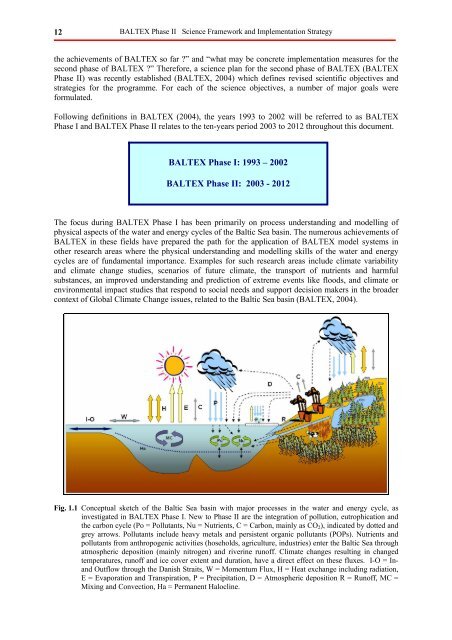BALTEX Phase II 2003 â 2012. Science Framework and ...
BALTEX Phase II 2003 â 2012. Science Framework and ...
BALTEX Phase II 2003 â 2012. Science Framework and ...
You also want an ePaper? Increase the reach of your titles
YUMPU automatically turns print PDFs into web optimized ePapers that Google loves.
12<br />
<strong>BALTEX</strong> <strong>Phase</strong> <strong>II</strong> <strong>Science</strong> <strong>Framework</strong> <strong>and</strong> Implementation Strategy<br />
the achievements of <strong>BALTEX</strong> so far ?” <strong>and</strong> “what may be concrete implementation measures for the<br />
second phase of <strong>BALTEX</strong> ?” Therefore, a science plan for the second phase of <strong>BALTEX</strong> (<strong>BALTEX</strong><br />
<strong>Phase</strong> <strong>II</strong>) was recently established (<strong>BALTEX</strong>, 2004) which defines revised scientific objectives <strong>and</strong><br />
strategies for the programme. For each of the science objectives, a number of major goals were<br />
formulated.<br />
Following definitions in <strong>BALTEX</strong> (2004), the years 1993 to 2002 will be referred to as <strong>BALTEX</strong><br />
<strong>Phase</strong> I <strong>and</strong> <strong>BALTEX</strong> <strong>Phase</strong> <strong>II</strong> relates to the ten-years period <strong>2003</strong> to 2012 throughout this document.<br />
<strong>BALTEX</strong> <strong>Phase</strong> I: 1993 – 2002<br />
<strong>BALTEX</strong> <strong>Phase</strong> <strong>II</strong>: <strong>2003</strong> - 2012<br />
The focus during <strong>BALTEX</strong> <strong>Phase</strong> I has been primarily on process underst<strong>and</strong>ing <strong>and</strong> modelling of<br />
physical aspects of the water <strong>and</strong> energy cycles of the Baltic Sea basin. The numerous achievements of<br />
<strong>BALTEX</strong> in these fields have prepared the path for the application of <strong>BALTEX</strong> model systems in<br />
other research areas where the physical underst<strong>and</strong>ing <strong>and</strong> modelling skills of the water <strong>and</strong> energy<br />
cycles are of fundamental importance. Examples for such research areas include climate variability<br />
<strong>and</strong> climate change studies, scenarios of future climate, the transport of nutrients <strong>and</strong> harmful<br />
substances, an improved underst<strong>and</strong>ing <strong>and</strong> prediction of extreme events like floods, <strong>and</strong> climate or<br />
environmental impact studies that respond to social needs <strong>and</strong> support decision makers in the broader<br />
context of Global Climate Change issues, related to the Baltic Sea basin (<strong>BALTEX</strong>, 2004).<br />
Fig. 1.1 Conceptual sketch of the Baltic Sea basin with major processes in the water <strong>and</strong> energy cycle, as<br />
investigated in <strong>BALTEX</strong> <strong>Phase</strong> I. New to <strong>Phase</strong> <strong>II</strong> are the integration of pollution, eutrophication <strong>and</strong><br />
the carbon cycle (Po = Pollutants, Nu = Nutrients, C = Carbon, mainly as CO 2 ), indicated by dotted <strong>and</strong><br />
grey arrows. Pollutants include heavy metals <strong>and</strong> persistent organic pollutants (POPs). Nutrients <strong>and</strong><br />
pollutants from anthropogenic activities (hoseholds, agriculture, industries) enter the Baltic Sea through<br />
atmospheric deposition (mainly nitrogen) <strong>and</strong> riverine runoff. Climate changes resulting in changed<br />
temperatures, runoff <strong>and</strong> ice cover extent <strong>and</strong> duration, have a direct effect on these fluxes. I-O = In<strong>and</strong><br />
Outflow through the Danish Straits, W = Momentum Flux, H = Heat exchange including radiation,<br />
E = Evaporation <strong>and</strong> Transpiration, P = Precipitation, D = Atmospheric deposition R = Runoff, MC =<br />
Mixing <strong>and</strong> Convection, Ha = Permanent Halocline.













